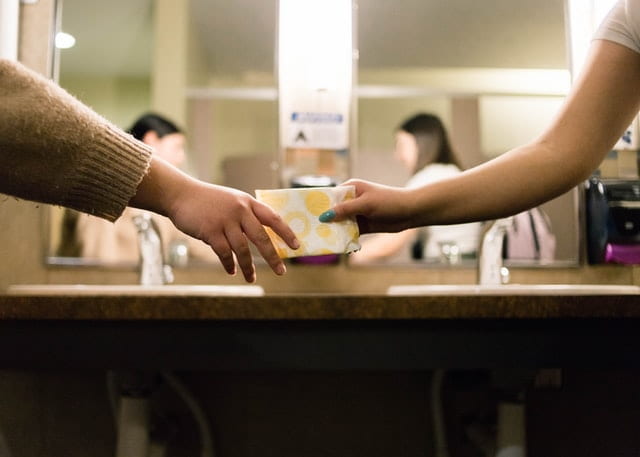The main idea behind creating Taboo Talks a public website is to let people feel free to share their experiences, ideas, views or content on topics they consider taboo.
That time of the Month: Menstruation
“Menstrual blood is the only source of blood that is not traumatically induced. Yet in modern society, this is the most hidden blood, the one is so rarely spoken of and rarely seen, except privately by women.”
Judy Grahn(Author of “Blood, Bread, and Roses: How menstruation created the world”)
What is Menstruation?

Menstruation (periods, menstrual cycle, menses) is a commonly occurring phenomenon in which blood and tissues from the uterus come out of the vagina. Every month your body prepares for pregnancy. The lining of the uterus gets thick to nurture the fertilized egg, and if the egg is not fertilized, this thick lining starts to break as it is no longer required and is expelled from the uterus with some blood through the vagina. Periods usually start menarche between age 11 and 14 and continue until menopause at about age 51. It occurs once a month and typically lasts for 3 to 5 days. Besides bleeding from the vagina, you may have
- Abdominal or pelvic cramping pain
- Lower back pain
- Bloating and sore breasts
- Food cravings
- Mood swings and irritability
- Headache and fatigue
Yet this natural phenomenon is loaded with myths, superstition, and secrecy in many societies worldwide.
Why periods are still taboo and considered a shame in India?

Words like “that time of the month,” “unwell,” “I’m not feeling well” are used to describe menstruation instead of periods and menstruation as it makes people uncomfortable to the point that menstrual products are wrapped up in newspaper and then sold.
The Menstrual taboo in India is rooted in the ancient Vedic text Rig Veda. Indra dev(king of gods) had killed a water demon Vritra who withheld water from people. Indra dev was overcome by guilt as Vritra was a learned Brahman.
It was then decided as punishment for Vritra’s murder; women would share Indra’s sin and suffer 1-3 of that guilt in the form of impurity, i.e., menstruation. Menstruation places numerous restrictions on women. They cannot offer prayers or enter into a temple, not permitted in the kitchen, touch pickle, and many more. These norms, perceptions create socioeconomic barriers and restrict them from accessing comfortable and dignified experiences with Menstrual Hygiene Management (MHM).
Whatever you have read above is a mere translation by some British scholars during colonial rule. During colonial rule, Britishers don’t know much about Sanskrit, and they tend to change the whole meaning of the sentence written on the Vedas. We need to understand that women during ancient times were worship and were seen as scared, so saying things like the taboo is coming from ancient civilizations is just a contradiction.
The four Vedas never state anywhere that a woman’s body is impure or cannot do poojas during menstruation. Therefore, prohibiting women from entering temples and denouncing them as impure is squarely against the teachings of the Vedas.
There may have been restrictions imposed on women in the past, but they are purely related to their health. There could be health and security-related issues in banning women from Sabarimala. During Full moon and no moon, nature is full of energy if women are given prescriptions to stay home and rest as it might harm their health. Calling prescription restrictions is wrong notions.
They were not permitted to go to the kitchen as women during the Menstrual cycle needed to rest. Women being considered a deity just cannot be called an impure being when the scientific community of that times were higher than today.
Agnihotra yagna, performed daily by vaidiks, is considered mahayagna, which means prominent among all yagnas. The Vedas stipulate that both men and women should perform this yagna without fail. If the yagna has to be served daily, how can a woman do it during her monthly periods?
In the Vedic age, there were no restrictions on women to perform rituals.
There is nothing “impure,” “unclean,” “evil” about menstruation. On the contrary, it is a perfectly normal body’s normal biological function similar to urination or defecation.
Is it only females who bleed?

The most common notion that people generally have is that women/girls bleed or is that only women/girls bleed, but not everybody who gets a period, identify as female. However, transgender men and genderqueer people with uterus, vagina, Fallopian tube, and ovaries also get periods.
“I’ve definitely seen a positive shift with the discussion around women experiencing periods, but the stigma towards trans men, nonbinary and intersex individuals having them is still alive and well,” said Kenny Ethan Jonas(transgender model and activist)
Some transgender people feel alienated while buying menstrual products as they are mainly categorized as ‘women’s products.’
Why menstrual cups and tampons are an issue in India?

Despite being reusable, feasible, eco-friendly menstrual cups and tampons are only used by a handful of menstruating people, most use non-biodegradable sanitary pads and clothes(if not disinfected property), which increases the risk of infection.
These revolutionary products’ most significant barrier is the “concept of losing Virginity,” a prized possession in many Indian societies. In addition, the idea of “inserting” something in the vagina every month is quite troublesome to many conservative families, which is illogical since hymen is an elastic tissue that is flexible and can’t be torn by using these cups. Moreover, this cup remains in the outer vagina and doesn’t necessarily harm the hymen.
Apart from this, lack of awareness, availability and fear of discomfort make menstruating populations restrain from these products.
Does the menstrual cycle affect women’s moods?

There are misconceptions commonly shared that the menstrual cycle affects women’s moods, causes depression or irritability, or menstruation is a painful, shameless, or impure experience.
In many cases, the woman’s normal mood variation is erroneously attributed to the menstrual cycle. Unfortunately, much of the research is weak. Still, there seems to be a minimal increase in mood fluctuations during the luteal and menstrual phases and a corresponding decline during the remainder of the cycle.
Menstruation, periods and, sex education in India

In North India, over 30% of girls drop out of school after they start menstruating, and a more significant number of girls between the age group of 12 and 18. Those who continue education miss five days of school every month during their menstrual cycle because schools don’t have separate toilets for girls.
Moreover, both men and women are taught very little and, in some cases, not at all about menstruation when they are in school. Women themselves did not know much about periods till they got their first periods. A UNICEF study published by Water Aid has revealed that 1 out of 3 girls in South Asia knew nothing about menstruation before getting it. In contrast, 10% of girls in India believe that menstruation is a disease.
Boys should not be left out of this discourse, leading to misinterpretations and misunderstandings about menstruation. Instead, they should be made aware of the changes in their bodies to appreciate them and support them better.
How can we remove this taboo and make India a better place for women?
“You can send women to the moon or Mars later. But, first, provide sanitary pads to them.”
Arunachalam Muruganantham (Padman of India)
Many movies, documentaries, articles flooding the internet had played their part in breaking the taboo around menstruation. Central and state governments have taken Certain steps to combat the stigma attached to menstruation.

For example, Menstrual Hygiene Scheme(MHS) was introduced by The Ministry of Health and Family Welfare to increase awareness and provide sanitary napkins under the name “free days” at a subsidized rate of ₹6 for a pack of six napkins. Menstrual health is coming out of the closet through initiatives like sanitary pads vending machines(Kerala being the first state to take the initiative).
Despite these many efforts, the major drawback faced is the proper disposal of sanitary napkins and the usage of old rags, newspapers, etc., by the rural menstruating population, especially and the choice between sanitary napkins or tampons.
Decoding Menstrual Taboos in India: Issues, Challenges and Solutions
The taboos associated with it and the causes behind this imposed stigma on girls and women but also to scrutinize the social and cultural position of the women in India at present.


